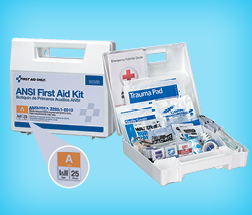Make sure you have the supplies you need to fulfill the new American National Standards Institute (ANSI) standard. In June of 2015, ANSI and International Safety Equipment Association (ISEA) updated the American National Standard—Minimum Requirements for Workplace First Aid Kits and Supplies (ANSI/ISEA Z308.1-2015) with an effective date of June 17, 2016. Read on to learn more about the requirements and what it means for you.
The new ANSI/ISEA standard introduces two classes of first aid kits based on the anticipated number of users intended to be served by each first aid kit, as well as the complexity of the work environment and level of hazards:
Class A kits deal with the most common type of workplace injuries.
Class B kits deal with injuries in more complex or high-risk environments and therefore, include a broader range and quantity of supplies.
Click here to link to a table listing the type and quantity of supplies required to meet requirements for Class A and Class B first aid kits.
Kit containers are another consideration in meeting the new standard. They are now classified into four types based on portability, ability to be mounted, resistance to water, and corrosion and impact resistance. Below is a brief explanation of each; click here for a more detailed explanation.
Type I: Intended for use in stationary, indoor applications where kit contents have minimal potential for damage due to environmental factors and rough handling.
Type II: Intended for use in portable indoor applications where the potential for damage due to environmental factors and rough handling is minimal.
Type III: Intended for portable use in mobile indoor and/or outdoor settings where the potential for damage due to environmental factors is not probable.
Type IV: Intended for portable use in mobile industries and/or outdoor applications where the potential for damage due to environmental factors and rough handling is significant.
You should consider the complexity of the work environment and level of hazards to determine the appropriate class and type of kit. The size and layout of your facility, availability of emergency services and number of employees are also factors when deciding the appropriate number of kits and whether supplemental supplies are needed. Competent personnel with an understanding of first aid, the hazards of a particular work environment and the number of employees at the site should determine the adequacy of a kit and its content.
Make sure you are aware of the new standards and have the supplies you need to meet the requirements. New System offers a wide range of first aid kits and supplies, everything you need to remain compliant.







